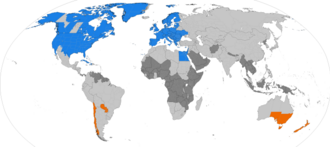Daylight saving time

Daylight saving time (DST) or summer time (ST) is a time to keep during summer. During the summer months, the sun stays visible for a longer time, and sunset happens late in the day. For this reason, certain countries advance the time by one hour near the start of summer, and put it back one hour during autumn.
DST helps stores that sell to people after they get off work, and it does not hurt farmers and others whose hours are set by the sun. It cuts traffic accident rates. Sometimes it can reduce energy costs, but it can also increase them.
Most of the world's countries do not use DST, but it is common in Europe and North America.
The United States, Australia, the United Kingdom, Canada and many other countries have DST. These countries also have regions that do not have DST:
- United States: most of Arizona and Hawaii
- Australia: Queensland, Western Australia and the Northern Territory
- Canada: Saskatchewan except for a few locations with the border with Alberta and Manitoba, and the Yukon Territory
Iceland, Russia, Belarus, and some parts of Ukraine are countries in Europe without DST.
As of January 2024[update], the following places plan to start and end DST at the following times:[1][2]
| Places | DST start | DST end | Shift | |
|---|---|---|---|---|
|
Second Sunday in March at 02:00 | First Sunday in November at 02:00 | 1 hour | |
| Second Sunday in March at 00:00 | First Sunday in November at 01:00 | 1 hour | ||
|
Last Sunday in March at 01:00 [UTC] | Last Sunday in October at 01:00 [UTC] | 1 hour | |
| Last Sunday in March at 02:00 | Last Sunday in October at 03:00 | 1 hour | ||
| Last Sunday in March at 00:00 | Last Sunday in October at 00:00 | 1 hour | ||
| Friday before last Sunday in March at 02:00 | Last Sunday in October at 02:00 | 1 hour | ||
| Second Saturday after Ramadan at 02:00 | Saturday before last Sunday in October at 02:00 | 1 hour | ||
| Last Friday in April at 00:00 | Last Thursday in October at 24:00 | 1 hour | ||
|
First Saturday in September at 24:00 [UTC−04:00] | First Saturday in April at 24:00 [UTC−03:00] | 1 hour | |
| First Sunday in October at 00:00 | Fourth Sunday in March at 00:00 | 1 hour | ||
| First Sunday in October at 02:00 | First Sunday in April at 03:00 | 1 hour | ||
| First Sunday in October at 02:00 | First Sunday in April at 02:00 | 30 minutes | ||
| Last Sunday in September at 02:00 [UTC+12:00] | First Sunday in April at 02:00 [UTC+12:00] | 1 hour | ||
In the table above, the DST times show the time before being moved forward or back. The shift is how much time is added at the DST start time and subtracted at the DST end time. For example, in Canada and the United States, the local time changes from 02:00 to 03:00 when DST starts and from 02:00 to 01:00 when DST ends. If a time zone is listed (e.g., UTC−04:00), all time zones in a country move forward and backward simultaneously; otherwise, time zones change in their local time. Areas shown in the same color start and end DST within less than a week of each other.
Europe
European Union
Since 1971 all clocks in the European Union have changed on same dates and at the same time, 06:00 GMT.[3]
European Summer Time begins (clocks go forward) at 01:00 UTC on the last Sunday in March, and ends (clocks go back) at 01:00 UTC on the last Sunday in October:
| Start | End |
|---|---|
| 27 March 2022 | 30 October 2022 |
| 26 March 2023 | 29 October 2023 |
| 31 March 2024 | 27 October 2024 |
| 30 March 2025 | 26 October 2025 |
| 29 March 2026 | 25 October 2026[note 1] |
| 28 March 2027 ? | 31 October 2027 |
| 26 March 2028 ? | 29 October 2028 |
- ↑ If the 2018 Commission proposal had been approved by the Council of Ministers, and member states opted to remain on winter time year round, the October 2022 clock change would have been the final clock change.
United Kingdom
Permanent Summer Time has support in some northerly countries such as the UK. It was tried in the British Standard Time experiment, with Britain remaining on GMT+1 throughout the year. This took place between 27 October 1968 and 31 October 1971.
There are proposals for GMT+1 in the winter, and DST summer time (GMT+2) in the summer. In favour are most city dwellers: children do not have to come home after school in the dark, and late afternoon and early evening activities benefit. In favour also were those concerned with accidents, because both accidents and fuel consumption go down.RoSPA suggests this would reduce the number of accidents over this period as a result of the lighter evenings.[4][5][6]
Against are many farmers in northerly latitudes, because sunrise would occur in winter at about 10:00 in the morning. However, in March 2010 the National Farmers Union said that it was not against Single/Double Summer Time, and is in fact relatively neutral, with many farmers expressing a preference for the change.[7]
Middle East and North Africa
Egypt
Israel
Lebanon
Palestine
North America
United States
The following table lists future starting and ending dates of daylight saving time in the United States:
| Year | Start | End |
|---|---|---|
| 2022 | March 13 | November 6 |
| 2023 | March 12 | November 5 |
| 2024 | March 10 | November 3 |
| 2025 | March 9 | November 2 |
| 2026 | March 8 | November 1 |
| 2027 | March 14 | November 7 |
| 2028 | March 12 | November 5 |
Canada
South America
Chile
Paraguay
Oceania
Australia
New Zealand
Automatic adjustment
Most mobile phones and computers connected to the Internet will automatically adjust their clocks for DST. Some computers will not adjust or will adjust the time incorrectly or on the wrong date. Also, computers with more than one operating system may be incorrectly adjusted twice or more when each operating system boots.
Daylight Saving Time Media
An ancient water clock that lets hour lengths vary with season
George Hudson was the first to propose modern DST, in 1895.
DST was first implemented in the United States to conserve energy during World War I (poster by United Cigar Stores).
Retailers generally favor DST; United Cigar Stores hailed a 1918 DST bill.
William Willett independently proposed DST in 1907 and advocated it tirelessly.[8]
A 2001 US public service advertisement reminded people to adjust clocks.
The William Willett Memorial Sundial in Petts Wood, south London, is always on DST.
Notes
{{notelist|refs= [a]
References
- ↑ "The World Clock (extended version)". timeanddate.com. Retrieved 1 March 2023.. Detailed DST information about each location, current and historical, can be found under the relevant section of this website, and can be referred to for information in this article unless otherwise specified.
- ↑ "Time zone database and code". Paul Eggert.
- ↑ British Summer Time Archived September 2, 2016, at the Wayback Machine
- ↑ "Press Release October 22, 2008 It's Time for a Change to Save Lives and Reduce Injuries". RoSPA Press Office. Archived from the original on Mar 17, 2009. Retrieved Sep 22, 2016.
- ↑ "British Summer Time (BST)". NMM – National Maritime Museum. Archived from the original on 2009-08-02. Retrieved 2016-09-22.
- ↑ Jha, Alok (Mar 29, 2010). "Lighter Later Guardian Article". The Guardian (London). http://www.guardian.co.uk/environment/2010/mar/29/lighter-later-climate-change-campaign.
- ↑ "Should we change the clocks?". National Farmers Union. Mar 18, 2010. Archived from the original on Mar 30, 2010. Retrieved Sep 23, 2015.
- ↑ Seize the Daylight (2005), p. 22.
Other websites
- Daylight Saving Time – Time Change. TimeAndDate.com
- About Daylight Saving Time - History, rationale, laws & dates Archived 2007-09-18 at the Wayback Machine. WebExhibits
Cite error: There are <ref> tags on this page, but the references will not show without a {{Reflist|group=lower-alpha}} template or a <references group="lower-alpha"/> tag.








